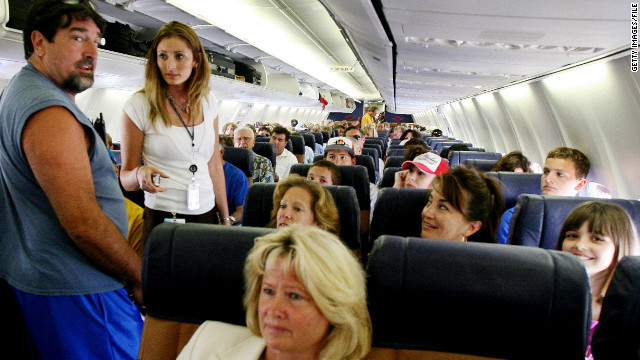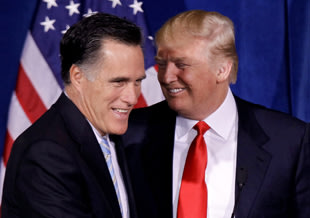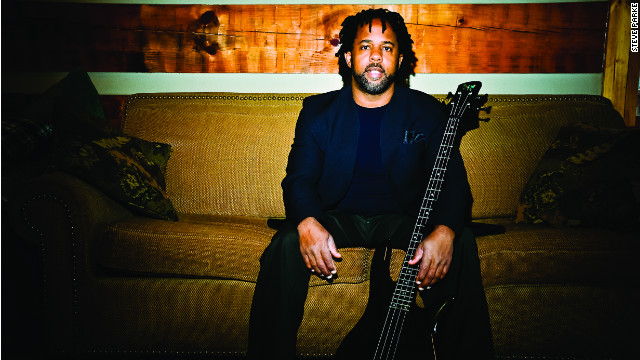By Thom Patterson, CNN

--More legroom: 41%
--More comfortable seating:30%
--More bin space, free snacks, seat outlets, fewer delays, better entertainment: 29%
2. On flights over 4 hours, would you pay $25 for more legroom?
--Yes: 35%
3. On domestic flights under 4 hours, would you pay for more legroom?
--No: 71%
Source: TripAdvisor poll of over 1,000 U.S. respondents
Seating configurations are going through some changes that will directly affect passenger comfort, convenience and cost.
STORY HIGHLIGHTS
- Airline seating changes will directly affect passenger comfort, convenience and cost
- Expert: Coach airline seats were designed using wrong dimensions
- Air passengers have multiple complaints about coach seating
Editor's note: The Traveler's Psyche is a five-week series focusing on travel scenarios that stir emotion. We're starting with frustration and will wind up on a happy note in June. This week we'll take a closer look at air rage, the TSA and people who love aviation.
(CNN) -- If you're on a flight -- especially a long one -- a coach class seat can be a chair of torture.
It doesn't take much these days to ruin a perfectly good airplane ride, CNN.com readers have made clear. It's a real buzzkill to try to walk down the aisle "with a bag on your shoulder, hitting everyone as you pass by," suggests user "Cajuncatdude." Commenter "Rosemeow" writes, "It's bad enough that about a quarter of the time, I have an obese person sitting next to me (sometimes on both sides) who doesn't fit into their own seat, crushing me."
And "MrsColumbo" complains about "people who don't even try to stand up without grabbing on to the seat in front and pulling themselves up. What is with that?"

For something as seemingly simple as stuffing rear ends between two armrests inside a flying metal tube, it kind of feels like there's some anger up there.
And things could get even more heated. Changes are happening now, as major U.S. carriers look for new ways to pump up profits by either adding to or reducing the number of coach seats, increasing legroom or cutting the distance between rows.
You might call it a game of aeronautical chairs that will directly affect passenger comfort, convenience and cost.
Two experts with inside knowledge of the airline seat industry-- a vice president at a seat manufacturer and a nationally recognized expert in the study of body measurements -- recently talked frankly about some of the reasons behind the anger and discomfort.
Are the seats getting smaller? Closer together? Are passengers getting bigger? Are we getting angrier?
Well, no. Yes. Yes. And it's unclear.
Americans are getting bigger, says Kathleen Robinette, who's studied human body measurements for the U.S. Air Force for three decades.
But in general, the problem's "not you -- it's the seat," she says with a chuckle.
Since Robinette's first airline seat study for NASA and the FAA in 1978, she has a different perspective when she boards an airliner. "I always see all kinds of arms hanging out into the aisles. That means the seats are too narrow, and there's nowhere for the shoulders and arms to go except into the aisle because there's not enough room in the seat."
When "you keep getting your arm whacked by the cart as it comes down the aisle," don't feel guilty, she says. It happens to everybody. "And it's because of the seats."
And what about passengers grabbing the seat in front of them to pull themselves out of their own seats? Is that really a thing?
Airplane seating has come a long way since 1925, when German airline seats looked like this.
"It can be quite annoying," laughs Jeff Luedeke, a vice president at airline seat manufacturer TIMCO Aerosystems, maker of seats aboard Allegiant, Japan Airlines, RwandAir, and Spirit Airlines. Seat grabbing creates a challenge for designers, said Luedeke, who flies about a quarter-million miles yearly. "If the rows weren't so close together that would probably prevent people from grabbing the back of the seat."
In 1962, the U.S. government measured the width of the American backside in the seated position. It averaged 14 inches for men and 14.4 inches for women. Forty years later, an Air Force study directed by Robinette showed male and female butts had blown up on average to more than 15 inches.
"The seat is a revenue generator," Luedeke says. "Normally if you look at a 737 or A320 there are three seats on each side. If you wanted maximum comfort you could do two on each side -- and make the seats a lot wider. But with the reduced head count the operational costs don't work out."
But the American rear end isn't really the important statistic here, Robinette says.
Nor are the male hips, which the industry mistakenly used to determine seat width sometime around the 1960s, she says.
"It's the wrong dimension. The widest part of your body is your shoulders and arms. And that's much, much bigger than your hips. Several inches wider." Furthermore, she says, women actually have larger hip width on average than men.
The industry used the male hip as a seat measuring stick "thinking that it would accommodate the women too, but in fact they don't accommodate the larger women."
The result: Airline seats are approximately 5 inches too narrow, she says. And that's for passengers in the 1960s, let alone the supersized U.S. travelers of today.
Current standard coach seat widths range from 17 to 19 inches between the armrests, says Luedeke, and that little piece of real estate is known in the industry as "living space."
The term seems appropriate for some non-stop transoceanic flights that will have you inhabiting your "living space" for up to 18 hours.
I look at it like, I've leased this space for the next three hours.
Jeff Luedeke, TIMCO Aerosystems
Jeff Luedeke, TIMCO Aerosystems
"I look at it like, I've leased this space for the next three hours -- or however long the flight is," Luedeke says. At a recent industry convention in Hamburg, Germany, TIMCO asked volunteers to test seats. The testers didn't know it, but some seats had cushions and some did not. Many of the testers laughed when they found out later that their seats had no cushions. Even funnier: Some passengers said the seats without cushions were more comfortable.
"One of the most important things about a comfortable seat is the ability to move in it," Robinette says. "You have to be able to readjust your posture every so often for it to stay comfortable." Otherwise, she warns, passengers put themselves at risk of deep vein thrombosis, a serious health condition affecting people prone to blood clots. Sitting in place for long periods can lead to clotting in veins. Clots can break loose, travel through the bloodstream and lodge in the lungs, blocking blood flow.
Although America's butts are bulging, it doesn't appear that economy class seats are following suit.
"Our seating surfaces are contemporarily appropriate," says a spokesman for Southwest Airlines. The airline is in the process of reconfiguring seating on its entire fleet. But it's not changing the width.
Seat rows aboard Southwest Boeing 737-700s are moving closer together. In airline-seat speak the operative word is "pitch."
Pitch is defined as the distance between one point on a seat and the same point on the seat behind. A typical seat pitch in coach measures from 31 to 35 inches, Luedeke says.
Southwest's new pitch configuration moves its rows about an inch closer together, from 32 to 31 inches, according to the airline. In addition, economy seats will move only two inches during recline instead of three, the airline says. Amazingly, because of the new seat design, the airline says coach passengers will be blessed with an extra inch of legroom. Will fliers notice the difference? Let us know.
Bottom line: Southwest's new economy class seats will allow for six additional coach seats per plane. Bonus: The new seats weigh less, which will save about $10 million in yearly fuel costs. It's an "environmental win and a revenue positive move on the extra seats," says the airline.
In general, coach seats haven't narrowed over the years, Luedeke says. "I believe it's more of a perception caused by seat pitches getting tighter."
So now -- if rows are moving closer together -- we're playing footsie with legroom.
That's important. Thirty percent of Americans who answered arecent poll by TripAdvisor said comfortable seating is the biggest improvement airlines could make. And 41% said airlines adding more legroom would be the biggest improvement.
Over the past few years carriers have been moving toward a standard of charging more for seats with extra legroom.
These include seats in the forward coach cabins and emergency aisles that used to cost the same as other economy class seats. Also, some airlines have reconfigured seats to add a bit more legroom in certain aisles, for a price.
United Airlines started selling its "Economy Plus" extra-legroom seats for premium prices a few years ago, and now it's expanding the program. To make space for the extra 5 inches of legroom, United is removing three to six seats, depending on the aircraft. Legroom for United regular coach seats will remain the same, with a pitch of 31 inches.
The special seating lures "higher revenue and more frequent customers," says a United spokesman. Some customers want more space, he says, but "there are other customers who value getting the cheapest price, and for them ... the seating is not their highest priority."
Delta followed with a similar program last year, and American Airlines in March. American said it's in the process of removing at least four to nine coach seats per aircraft to create the extra legroom. Price: from $8 to $108 -- depending on the flight. They call it their Main Cabin Extra program.
Airline comfort poll
1. What's the biggest improvement airlines could make? --More legroom: 41%
--More comfortable seating:30%
--More bin space, free snacks, seat outlets, fewer delays, better entertainment: 29%
2. On flights over 4 hours, would you pay $25 for more legroom?
--Yes: 35%
3. On domestic flights under 4 hours, would you pay for more legroom?
--No: 71%
Source: TripAdvisor poll of over 1,000 U.S. respondents
In the TripAdvisor survey, 71% said they weren't willing to pay for extra legroom on domestic flights under four hours.
"Some view the ability to select a seat as an additional fee," says Bryan Saltzberg of SeatGuru.com. "Some view the ability to actually secure more legroom as actually a benefit -- and they're willing to pay for that benefit. It depends on who you're talking to and the carrier."
By the way, here are three magic words in the airline seat business: articulating seat pan.
The articulating seat pan is what allows airlines to move seat rows closer together without losing legroom.
In a traditional reclining airline seat, only the seat back moves. But with an articulating seat pan, as the back moves to the rear, the seat pan moves forward. "The back of the seat isn't moving as far as it traditionally did, but the feeling you get is that it moves further," Luedeke says. Because the seat doesn't need as much room to recline, it saves space for more seats. Also, the back of the seat is thinner, saving even more space.
It looks like coach seats won't be getting any bigger any time soon. That's largely because consumers don't demand bigger seats, Robinette says. Consumers demand low fares, so that's what airlines offer, she says. Consumers who demand better seats fly first class.
"The manufacturers are perfectly willing to make the wider seats," Robinette says. "They understand the issues. But their customers are the airlines. And they're giving the airlines what they ask for. The airlines are also giving their customers -- the passengers -- what they want. So the consumer needs to be smarter. The consumer is the one who needs to drive the width of the seats."
What do you think? It's a tricky balancing act between affordable fares and comfortable seating. Are airlines offering economy class passengers what they want? Let us know what you think in the comment area below.







